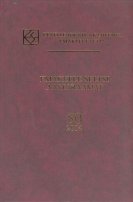Eesti keele verbimoodustus: desubstantiivne konversioon
Verb formation in Estonian: denominal conversion
Author(s): Silvi VareSubject(s): Language and Literature Studies
Published by: Teaduste Akadeemia Kirjastus
Keywords: word formation; conversion; productivity; Estonian
Summary/Abstract: Conversion as a method of forming new words by only changing the part of speech without making use of a derivational suffix is a well-known fact in Estonian. In principle transposition without a suffix is possible between all the main parts of speech, for example, the noun lõhn ‘smell’ > verb lõhna/ma ‘to emit a smell’ [-ma being the infinitive marker]. However, denominal verb conversion or the transition of a pure noun stem into a verb stem is particulary characteristic of Estonian. In addition to derivation, it is the second most important method of verb formation in Estonian. One can find examples of such verbs already in the earliest grammar of Estonian by H. Stahl (1637), and data from the contemporary language prove that the type is productive now, too. Despite being relatively common, this area has been largely neglected in Estonian word formation in comparison with derivation and compounding. The author deals with the phenomenon from the synchronic perspective, providing an overview of the extent of denominal verb conversion, morphophonological preconditions, structural patterns, and productivity in contemporary Standard Estonian over the past four decades. The author shows on the basis of extensive material that the possibility of conversion in a type depends on the morphophonological structure of the noun stem, which must meet certain conditions. The most important precondition is the existence of a primary root stem.Most verbs formed by means of conversion are derived from nouns with primary simple stems that have one syllable in the base form and end in a consonant.The article also deals with the relation between the stem and form as conversion basis. Generally speaking, the type under discussion reveals verbation of a noun stem. In addition, there are a few examples where one can presume that the inflectional form has developed into a verb stem. . In such cases one might assume that conversion is based on a construction with the meaning of state, for example, kühmu (illative) tõmbu/ma ‘to hunch one’s shoulders’ > kühmu/ma (cf. kühm ‘hunch’). In this case conversion is related to univerbation.
Journal: Emakeele Seltsi aastaraamat
- Issue Year: 2004
- Issue No: 50
- Page Range: 039-067
- Page Count: 28
- Language: Estonian

